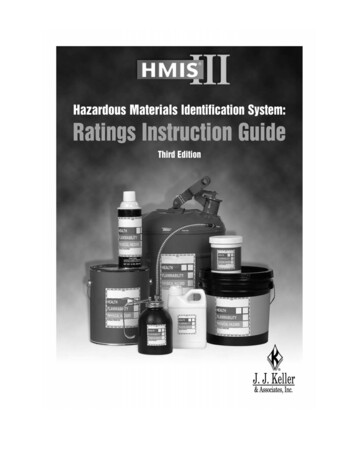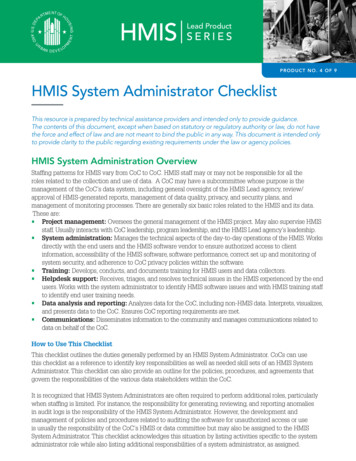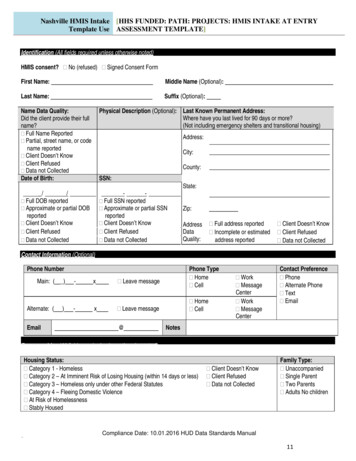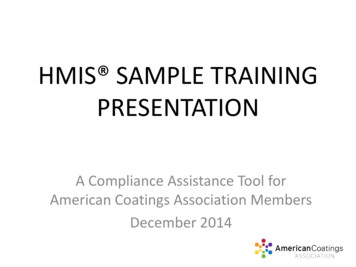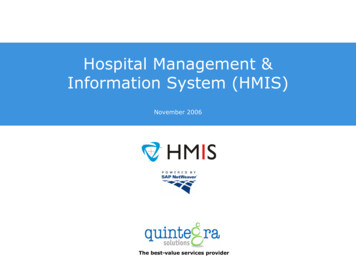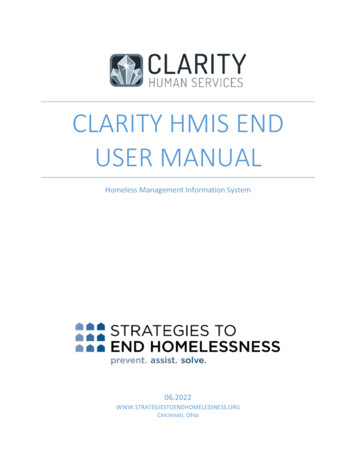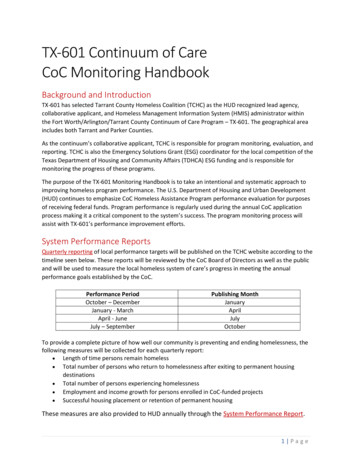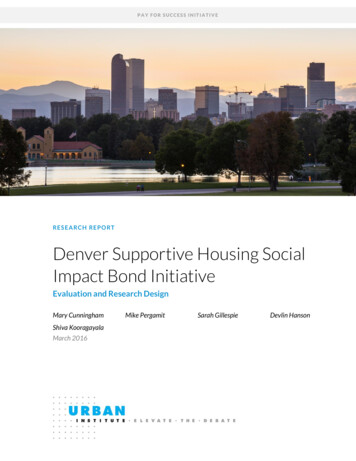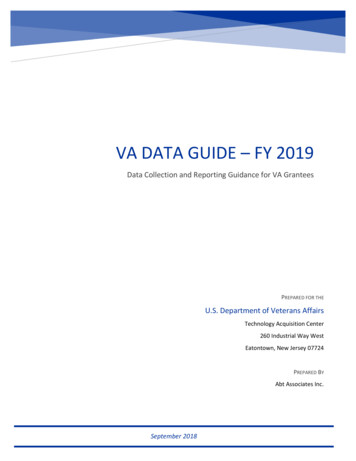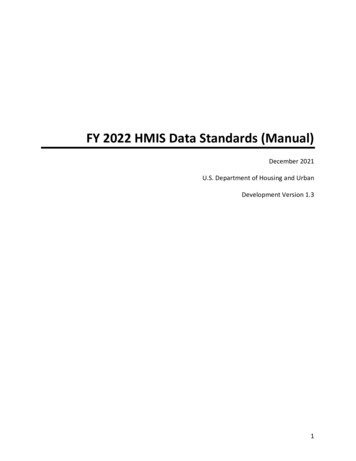
Transcription
FY 2022 HMIS Data Standards (Manual)December 2021U.S. Department of Housing and UrbanDevelopment Version 1.31
FY 2022 HMIS Data Standards Change LogFY 2022 HMIS Data Standards Change LogNumberNameElement StructureInformationBeforeAfterAdded clarifications and updatesregarding FY 2022 changesProject InformationAdded “Medically Assisted LivingFacility” for HOPWA funded projects.Added definition of “ParticipatingProject”Descriptions updated2.06Funding Sources49 - HUD: CoC - Joint ComponentRRH/PSH50 – HUD: HOME51 – HUD: HOME (ARP)52 – HUD: PIH (Emergency HousingVoucher)2.07Bed and UnitInventoryInformationInstructions updated3.03Date of Birth2.023.043.053.06Race1 - American Indian orAlaska Native2 - Asian3 - Black or AfricanAmerican4 – Native Hawaiian orOther Pacific IslanderEthnicity1 – Non-Hispanic/Latino2 - Hispanic/LatinoGender0 - Female1 - Male2 - Trans Female (MTF orMale to Female)3 - Trans Male (FTM orFemale to Male)4 - Gender Non-ConformingSystem Logic and Other SystemIssues updated1 - American Indian, Alaska Native,or Indigenous2 - Asian or Asian American3 – Black, African American, orAfrican4 – Native Hawaiian or PacificIslanderDescriptions updated0 – Non-Hispanic/Latin(a)(o)(x)1 - Hispanic/Latin(a)(o)(x)(Select as many as apply)0 - Female1 - Male4 - A gender that is not singularly‘Female’ or ‘Male’5 - Transgender6 - QuestioningDescriptions, guidance, and SystemLogic and Other System Issuesupdated2
NumberName3.11Project Exit DateRelationship to3.15Head of HouseholdHousing Move-In3.20Date4.02Income and Sources4.03Non-Cash Benefits4.094.104.124.144.20C1C2C3W1Mental HealthDisorderSubstance UseDisorderCurrent LivingSituationBed Night DateMental Health ProblemSubstance AbuseCoordinated Entry EventWell-beingMoving OnAssistance ProvidedYouth EducationStatusServices Provided - 12 - Substance abuseHOPWAservices/treatmentW3Medical AssistanceW4T-cell (CD4) andViral LoadPage 3BeforeAfterAdded auto-exit functionality logicSystem Logic and Other SystemIssues updatedSystem Logic and Other SystemIssues updatedSystem Logic and Other SystemIssues updated. Earned Incomedescription updated.System Logic and Other SystemIssues updatedRevised to Mental Health DisorderthroughoutRevised to Substance Use DisorderthroughoutGuidance updatedGuidance updated16 - Referral to emergencyassistance/flex fund/furnitureassistance17 – Referral to Emergency HousingVoucher (EHV)18 – Referral to a Housing StabilityVoucherNew ElementNew ElementNew Element12 - Substance use disorderservices/treatmentAdd Field 3 "Receiving Ryan Whitefunded Medical or DentalAssistance" and response optionsand "Reason" dependencyUpdated "Data Collected About" toensure consistency with otherHOPWA data elements
FY 2022 HMIS Data Standards Change LogNumberW6R10R13V7BeforeAfterNew ElementAdded “HUD: CoC PermanentSupportive Housing” toFunder/Component RequirementGeneral HealthStatusR7V3NamePrescribed AntiRetroviralData Collected AboutData Collected About "Head of"Female Head of HouseholdHousehold and Adults"and Female Adults"Revised Mental Health Disorder andFamily Critical IssuesSubstance Use Disorder language inresponse options11 - General housing12 - General housing stabilitystability assistance assistanceFinancial Assistance emergency supplies16 - Food Assistance12 - General housingRe-ordered liststability assistance - otherHP TargetingSignificant element revisionsCriteriaPregnancy StatusVersion HistoryV1.1 – August 2021 V1.2 – September2021V1.3 – December2021 NotesUpdated instructions for 2.07Updated system logic for 3.11V7 – removed field A and re-numbered response options for entireelement.Updated XML locations for C1 Well-being, C2 Moving On AssistanceProvided, C3 Youth Education Status, and W6 Prescribed AntiRetroviralRemoved “The system must record the appropriate collection stagefor each element.” from the System Logic in C2 Moving onAssistance Provided.Updated/Corrected the following XML tags:o 3.20 Housing Move-In Date XML MoveInDate o 4.13 Date of Engagement XML DateOfEngagement o R4 Last Grade Completed XML Education LastGradeCompleted o R5 School Status XML SchoolStatus LastGradeCompleted 3.11 fix to System LogicW6 System Logic UpdatedR8 & R9 removed “HUD VASH” from Funder Component applicability4.20 Dependent C response type updated4
ContentsFY 2022 HMIS Data Standards Change Log v1.0 . 11. INTRODUCTION TO THE HMIS DATA STANDARDS . 81.1 HMIS DATA STANDARDS OVERVIEW . 8Related Documents. 9HMIS Federal Partner Program Manuals . 9HMIS Data Standards Terms and Concepts . 10Data Element Structure . 111.2 INTRODUCTION TO PROJECT DESCRIPTOR DATA ELEMENTS . 16HMIS Project Setup Guidance . 17Multiple Funding Sources . 18Multiple Project Setup . 19Projects that Operate in Multiple CoCs . 201.3 INTRODUCTION TO UNIVERSAL DATA ELEMENTS . 21General Data Collection Guidance . 22Uses and Disclosures of Client Data. 221.4 INTRODUCTION TO PROGRAM SPECIFIC DATA ELEMENTS . 22Common Program Specific Data Elements . 23Federal Partner Program Data Elements . 231.5 INTRODUCTION TO METADATA ELEMENTS. 251.6 DATA COLLECTION GUIDANCE BY PROJECT TYPE . 26Street Outreach. 26Coordinated Entry . 27'Night-by-Night' Emergency Shelters . 29'Entry/Exit' Emergency Shelter and Transitional Housing . 30Day Shelter . 30Permanent Housing: PSH and RRH . 302. Project Descriptor Data Elements. 322.01 Organization Information . 322.02 Project Information . 332.03 Continuum of Care Information . 502.06 Funding Sources . 532.07 Bed and Unit Inventory Information . 583. Universal Data Elements . 67Universal Identifier Elements (One and Only One per Client Record) . 673.01 Name . 673.02 Social Security Number . 693.03 Date of Birth . 713.04 Race . 743.05 Ethnicity. 763.06 Gender . 783.07 Veteran Status . 81Page 5
FY 2022 HMIS Data Standards Change LogUniversal Project Stay Elements (One or More Value(s) Per Client or Household Project Stay). 843.08 Disabling Condition . 843.10 Project Start Date. 873.11 Project Exit Date. 893.12 Destination . 923.15 Relationship to Head of Household . 943.16 Client Location . 973.20 Housing Move-in Date . 983.917 Prior Living Situation . 1004. Program Specific Data Elements . 111Common Program Specific Data Elements . 1114.02 Income and Sources . 1114.03 Non-Cash Benefits . 1184.04 Health Insurance . 1224.05 Physical Disability . 1264.06 Developmental Disability . 1294.07 Chronic Health Condition . 1314.08 HIV/AIDS . 1354.09 Mental Health Disorder. 1374.10 Substance Use Disorder . 1404.11 Domestic Violence . 1434.12 Current Living Situation . 1474.13 Date of Engagement . 1514.14 Bed-Night Date. 1524.19 Coordinated Entry Assessment . 1534.20 Coordinated Entry Event . 156Federal Partner Program Data Elements . 164Continuum of Care (CoC) . 165C1 Well-being . 165C2 Moving On Assistance Provided . 167C3 Youth Education Status . 168HOPWA . 170W1 Services Provided - HOPWA . 170W2 Financial Assistance - HOPWA . 172W3 Medical Assistance . 173W4 T-cell (CD4) and Viral Load . 176W5 Housing Assessment at Exit . 178W6 Prescribed Anti-Retroviral . 180PATH . 181P1 Services Provided - PATH Funded . 181P2 Referrals Provided - PATH . 184P3 PATH Status. 187P4 Connection with SOAR . 1896
RHY . 190R1 Referral Source . 190R2 RHY - BCP Status . 191R3 Sexual Orientation . 193R4 Last Grade Completed . 194R5 School Status. 196R6 Employment Status. 198R7 General Health Status . 199R8 Dental Health Status . 200R9 Mental Health Status . 201R10 Pregnancy Status . 202R11 Formerly a Ward of Child Welfare/Foster Care Agency . 204R12 Formerly a Ward of Juvenile Justice System . 205R13 Family Critical Issues . 206R14 RHY Service Connections . 208R15 Commercial Sexual Exploitation/Sex Trafficking . 212R16 Labor Exploitation/Trafficking . 216R17 Project Completion Status . 218R18 Counseling. 221R19 Safe and Appropriate Exit . 222R20 Aftercare Plans. 223RHSAP . 225U1 Worst Housing Situation. 225VA . 225V1 Veteran's Information. 225V2 Services Provided - SSVF . 229V3 Financial Assistance - SSVF . 232V4 Percent of AMI (SSVF Eligibility) . 233V5 Last Permanent Address . 234V6 VAMC Station Number . 235V7 HP Targeting Criteria. 236V8 HUD-VASH Voucher Tracking. 240V9 HUD-VASH Exit Information . 2425. Metadata Elements. 2445.01 Date Created . 2445.02 Date Updated . 2445.03 Data Collection Stage . 2455.04 Information Date . 2495.05 Project Identifier . 2505.06 Enrollment Identifier. 2515.07 User Identifier . 2525.08 Personal Identifier. 2535.09 Household Identifier . 254Appendix A - Living Situation Response Categories and Descriptions . 256Page 7
1.INTRODUCTION TO THE HMIS DATA STANDARDS1.INTRODUCTION TO THE HMIS DATA STANDARDS1.1HMIS DATA STANDARDS OVERVIEWA Homeless Management Information System (HMIS) is the information system designated by alocal Continuum of Care (CoC) to comply with the requirements of CoC Program interim rule 24CFR 578. It is a locally implemented data system used to record and analyze client, service, andhousing data for individuals and families who are homeless or at risk of homelessness.HMIS is administered by the U.S. Department of Housing and Urban Development (HUD)through the Office of Special Needs Assistance Programs (SNAPS) as its comprehensive dataresponse to the congressional mandate to report annually on national homelessness. It is usedby all projects that target services to persons experiencing homelessness within SNAPS and theoffice of HIV-AIDS Housing. It is also used by other Federal Partners from the U.S. Departmentof Health and Human Services (HHS) and the U.S. Department of Veterans Affairs and theirrespective programs to measure project performance and participate in benchmarking of thenational effort to end homelessness.The HMIS Data Standards were first published by HUD in 2004 as the HMIS Data and TechnicalStandards. HUD, in collaboration with its Federal Partners, has continued to update the HMISData Standards regularly thereafter. Each updated document supersedes the previouslyreleased HMIS Data Standards. A complete historical archive of previous data standards can befound on the HUD Exchange Data Standards page.An HMIS software must be able to collect all the data elements defined within these HMIS DataStandards, support the system logic identified, and ensure that the visibility of data elements isappropriate to the Project Type and Funding Sources for any given project.Comparable databases are required for use by providers of services for victims of domesticviolence, as described in the Violence Against Women Act (VAWA).There are many software products on the market that communities across the country havechosen to use as their HMIS. Each product has unique features and was built to meet thedifferent data collection needs of each community. Each software vendor should provide theguidance, support, and documentation necessary for the CoC to understand the system theyare using.Communities may elect to add data elements, add response categories, or maintain historicaldata element collection beyond what is specified in the Data Standards as long as it does notimpact the ability of the CoC to accurately collect and report on the required data elements. Inthese cases, HMIS Leads should work directly with their HMIS software providers to meet theirindividual needs.8
Related DocumentsThere are a variety of documents that comprise the suite of HMIS Data Standard resources.Each of the documents has a specific purpose and intended audience. The HMIS Lead should befamiliar with all of the documents and collectively use them as their HMIS reference materialsalong with any supplemental instructional materials provided by the software vendor. FY2022 HMIS Data Standards (Manual) FY2022 HMIS Data Standards (Dictionary) Data Exchange Resources: FY2022 CSV Programming Specifications FY2022 XML Programming Specifications FY2022 Data Logic ModelHMIS Federal Partner Program ManualsThese manuals contain specific and detailed information on project setup for each of theFederal Partners participating in HMIS including: HMIS project typing, the specific dataelements required for collection by that Federal Partner, program-specific meanings anddefinitions, and key information that the Federal Partner has identified as required for theirprogram. Each Manual was created jointly by HUD and the relevant Federal Partner, andapproved by both entities prior to publishing.Manual NameFederal PartnerProgram (s)U.S. Department of Housing andCoC Program Urban Development - Office ofAll Continuum of Care (CoC) ProgramSpecialNeedsAssistanceProgramsHMIS Manualcomponent projects.CoC Program Information linkU.S. Department of Housing andESG Program Urban Development - Office ofAll Emergency Solution Grant (ESG)SpecialNeedsAssistanceProgramsHMIS ManualProgram component projects.ESG Program Information linkU.S. Department of Housing andHOPWAUrban Development - Office ofProgram HMIS HIV/AIDS HousingManualHOPWA Program Information linkPage 9All Housing Opportunities for Personswith AIDS (HOPWA) program componentprojects.
1.Manual NameINTRODUCTION TO THE HMIS DATA STANDARDSFederal PartnerProgram (s)U.S. Department of Health andHuman Services - Substance Abuse All Projects for Assistance in TransitionPATH Program and Mental Health Servicesfrom Homelessness (PATH) componentHMIS Manual Administrationprojects.PATH Program Information linkU.S. Department of Health andHuman Services - Administration forRHY Program Children and Families - Family and All Runaway and Homeless YouthHMIS Manual Youth Services Bureauprogram component projects.RHY Program Information LinkVA Program Department of Veterans AffairsHMIS Manual VA Program information linkSupportive Services for Veteran Families(SSVF), Grant-Per-Diem (GPD), andHealthcare for Homeless Veterans (HCHV)Veteran homeless programs.U.S. Department of Housing andVASH Program Urban Development - VASH andHMIS Manual Department of Veterans AffairsVASH Program linkVeterans Affairs Supportive Housing(VASH) program.HMIS Data Standards Terms and ConceptsContinuum of Care (CoC) is used in multiple ways throughout the Data Standards: Continuum of Care and Continuum means the group organized to carry out theresponsibilities required under the CoC Program Interim Rule (24 CFR Part 578) andcomprises representatives of organizations, including nonprofit homeless providers,victim service providers, faith-based organizations, governments, businesses, advocates,public housing agencies, school districts, social service providers, mental healthagencies, hospitals, universities, affordable housing developers, law enforcement, andorganizations that serve homeless and formerly homeless persons to the extent thatthese groups are represented within the geographic area and are available toparticipate. CoC Program refers to the HUD funding source which provides housing and/or servicegrant dollars. Continuum Project refers to a distinct unit of an organization, which may or may not befunded by HUD or the Federal Partners, whose primary purpose is to provide services10
and/or lodging for the homeless and is identified by the Continuum as part of its servicesystem. For example, a project funded by the HUD's CoC Program may be referred tothen as a “CoC Program-funded continuum project.”HMIS User means the individual who uses or enters data in an HMIS or a comparable databaseapproved by the CoC.HMIS Lead means the entity designated by the Continuum of Care in accordance with the HMISProposed Rule (24 CFR Part 580) to operate the Continuum's HMIS on the Continuum's behalf.As of May 2021, the HMIS Rule is not in effect. When HUD publishes the final HMIS Rulecommunities will be given time to come into compliance with the rule.HMIS System Administrator means the individual(s) whose job it is to manage the HMISimplementation at the local level: providing agency access to HMIS and managing appropriateuse, supporting users through connection to, or direct provision of, user training, andoverseeing system setup.Project and Program are terms used to mean different things across the federal agencies. Inthis document, and for the purposes of data collection in HMIS, a program refers to the federalfunding source (e.g., HUD CoC, HHS PATH, VA SSVF, etc.) whereas a project refers to a distinctunit of an organization as set up in the HMIS.Data Element StructureEvery data element required by HUD and the Federal Partners to be stored within an HMIS isspecified in this document. The following format is used to describe each data element:Rationale: provides a basic explanation for data collection for the element and describes howthe data are used in national or local reporting.Data Collection Instruction: provides overall instructions for data collection and entry.Additional information regarding project setup and data collection instructions specific to anHMIS Federal Partner program can be found in the HMIS Federal Partner Program Manuals.System Logic and Other System Issues: Describes logically required data collection or systemstructure information for HMIS software development purposes and information on rationale,conditions, constraints, etc. that may be applicable to a specific element and are important forHMIS software development purposes.FY2022 Revision Summary: Documents the initial change(s) to the element from the 2020 DataStandard to the FY2022 Data Standard. Corrections made resulting in new FY 2022 DataStandard versions are tracked in Summary of Changes and by logical version numbering.Data Element Number and Name:Page 11
1.INTRODUCTION TO THE HMIS DATA STANDARDSTable Section Information contained in the tableField Number The numbers assigned to the element fields.Field NameThe names assigned to the element fields.DependencyDependent Fields and the Field/ Response category to which they aredependent.The dep
1 . FY 2022 HMIS Data Standards (Manual) December 2021 . U.S. Department of Housing and Urban . Development Version 1.3
